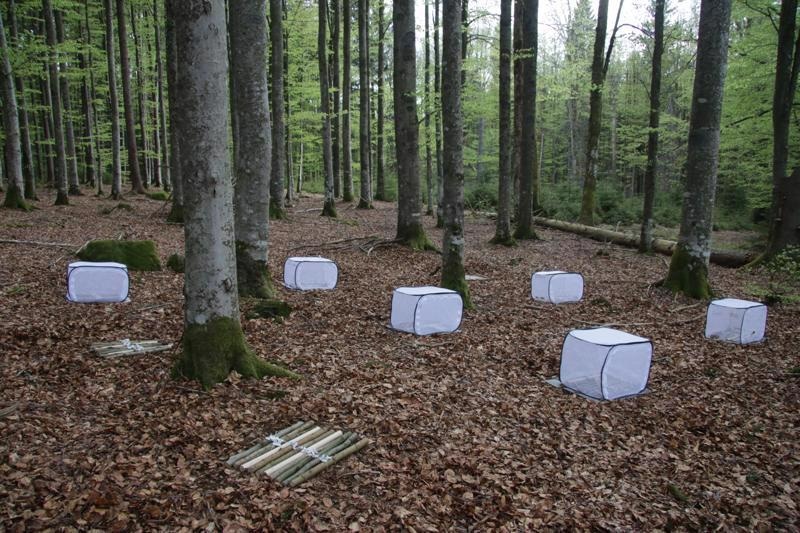Reviewed by Alex SmithSep 2 2021
The rate of decomposition of deadwood in forests relies on the climate as well as on insects and fungi. An international group of researchers has determined the yearly contribution made by deadwood to the global carbon cycle and assessed the significance of insects in the decomposition of wood for the first time.
 Experiment with deadwood in the Bavarian Forest National Park: some of the wood is kept in cages to keep insects at bay. Image Credit: Sebastian Seibold.
Experiment with deadwood in the Bavarian Forest National Park: some of the wood is kept in cages to keep insects at bay. Image Credit: Sebastian Seibold.
A significant amount of carbon dioxide from the air is absorbed by living trees, which, therefore, play a vital role in safeguarding the climate. However, not much is known regarding the role of dead trees in the global carbon cycle. The decomposition of wood and the recycling of the nutrients in it are the most essential processes occurring in forests.
A global research project launched by the Bavarian Forest National Park and collaborated by the Julius Maximilian University of Würzburg (JMU) and the Technical University of Munich (TUM) investigates the amount of carbon released from decaying wood on a global scale and the role played by the insects in this process.
An Experiment at 55 Different Locations Provides the Basis
The researchers chose around 55 forest locations on six continents and laid out wood from over 140 tree species to evaluate the impact of climate on the rate of decomposition. Half of the wood was kept in mesh cages. Such cages help prevent the involvement of insects in the decomposition and enable their contribution to wood decomposition to be measured.
The gathered data shows that the contribution of insects and the rate of decomposition are entirely dependent on the climate and tend to increase when there is a rise in temperature. Greater levels of precipitation tend to expedite the decomposition in warmer regions and slow it down in regions where the temperatures are lower.
Across the world, 50 research groups completed the three-year experiment, at times working under very hard conditions. Elaborate measures had to be used to safeguard certain areas from elephants. A forest fire destroyed one area and had to be rebuilt, and another area was flooded.
Global Carbon Cycling
On the basis of the experiment, we were able to model the role that deadwood plays in the global carbon cycle.
Rupert Seidl, Professor of Ecosystem Dynamics and Forest Management, Technical University of Munich
“According to the report, some 10.9 giga-tons of carbon are released from deadwood worldwide every year. In this context, part of the carbon is absorbed into the soil, while another part is released into the atmosphere. The amount of carbon released from deadwood is equivalent to roughly 115 percent of the emissions from fossil fuels,” added Dr. Werner Rammer, a scientist at TUM who played the leading role in the global calculations.
At 93 percent, tropical forests contribute disproportionately to this result due to their high wood mass combined with their rapid decomposition processes. Decomposition in temperate and boreal forests is considerably slower indicating that deadwood stores carbon over long time periods in these regions.
Dr. Sebastian Seibold, PD, Study Lead Author, Technical University of Munich
“Insects account for almost one-third of wood decomposition, although this is mostly confined to the tropics. In boreal and temperate forests, the contributions made by insects are small, though,” added Seibold.
The Effects of Global Change
“The study highlights the role played by deadwood in the global carbon cycle and the functional importance of insects in the decomposition of wood. In this way, we are closing another gap in the global modeling of carbon cycles,” explained Professor Jörg Müller, Head of Research at the Bavarian Forest National Park and the Ecological Station at JMU Würzburg.
At a time of global change, we can see some dramatic declines in biodiversity and changes in climate. This study has demonstrated that both climate change and the loss of insects have the potential to alter the decomposition of wood, and therefore, the carbon and nutrient cycles worldwide.
Dr. Sebastian Seibold, PD, Study Lead Author, Technical University of Munich
Journal Reference:
Seibold, S., et al. (2021) The contribution of insects to global forest deadwood decomposition. Nature. doi.org/10.1038/s41586-021-03740-8.